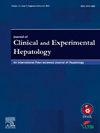Indian National Association for the Study of Liver (INASL) Guidance Statements for Determining Futility in Liver Transplantation
IF 3.2
Q2 GASTROENTEROLOGY & HEPATOLOGY
Journal of Clinical and Experimental Hepatology
Pub Date : 2025-03-28
DOI:10.1016/j.jceh.2025.102539
引用次数: 0
Abstract
Liver transplantation (LT) is a life-saving procedure for patients with end-stage liver disease; however, with the growing shortage of organ donors, the need to identify futile transplants has become increasingly urgent. Futility in liver transplantation refers to situations where the expected post-transplant survival or quality of life is poor, making the procedure unlikely to yield a meaningful benefit. Various definitions of futility are used across different countries and transplant centers, with criteria often based on clinical factors such as age, comorbidities, MELD score, and functional status. For hepatologists and transplant surgeons, clearer guidelines are essential to make informed decisions and avoid unnecessary transplants that may place patients at risk without improving their prognosis. While some studies have proposed futility scores, there is currently no universal consensus on a standardized definition or set of criteria. This highlights the need for further prospective trials to evaluate the predictors of futility in liver transplantation, aiming to refine decision-making processes, optimize organ allocation, and improve patient outcomes. Future research should focus on the development of universally accepted futility criteria and explore interventions to mitigate the factors contributing to transplant futility.
印度国家肝脏研究协会(INASL)确定肝移植无效的指导声明
肝移植(LT)是终末期肝病患者的救命手段;然而,随着器官供体的日益短缺,识别无效移植的需求变得越来越迫切。肝移植无效是指预期移植后生存或生活质量较差的情况,使得该手术不太可能产生有意义的益处。在不同的国家和移植中心使用不同的无效定义,其标准通常基于临床因素,如年龄、合并症、MELD评分和功能状态。对于肝病学家和移植外科医生来说,更明确的指导方针对于做出明智的决定和避免不必要的移植至关重要,这些移植可能会使患者处于危险之中,而不会改善预后。虽然一些研究提出了无用性评分,但目前还没有一个标准化的定义或一套标准的普遍共识。这突出表明需要进一步的前瞻性试验来评估肝移植无效的预测因素,旨在改进决策过程,优化器官分配,改善患者预后。未来的研究应侧重于制定普遍接受的无效标准,并探索干预措施以减轻导致移植无效的因素。
本文章由计算机程序翻译,如有差异,请以英文原文为准。
求助全文
约1分钟内获得全文
求助全文
来源期刊

Journal of Clinical and Experimental Hepatology
GASTROENTEROLOGY & HEPATOLOGY-
CiteScore
4.90
自引率
16.70%
发文量
537
审稿时长
64 days
 求助内容:
求助内容: 应助结果提醒方式:
应助结果提醒方式:


